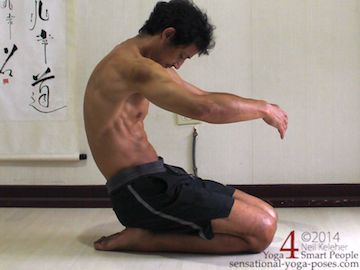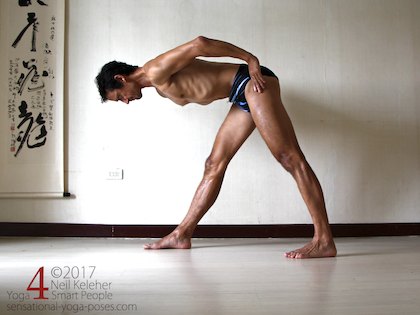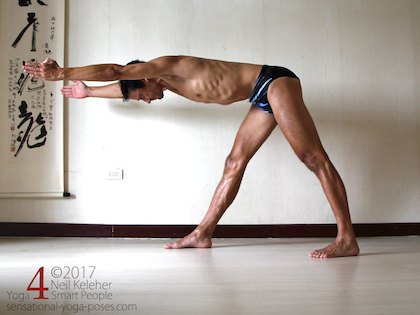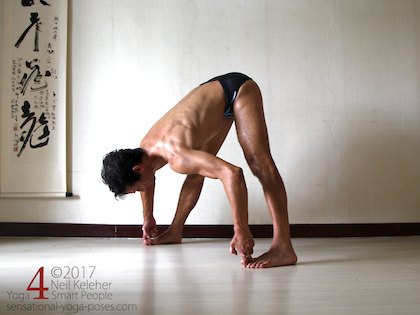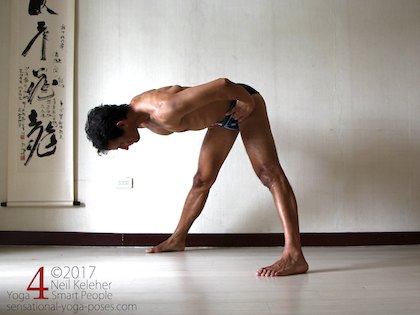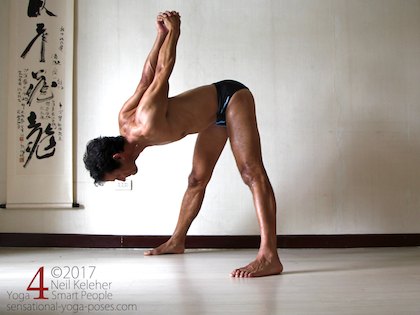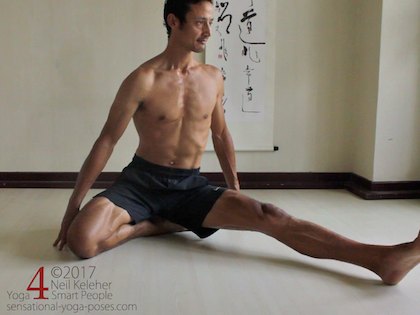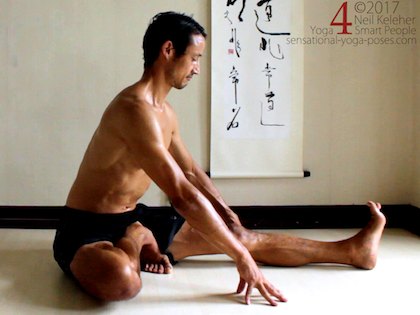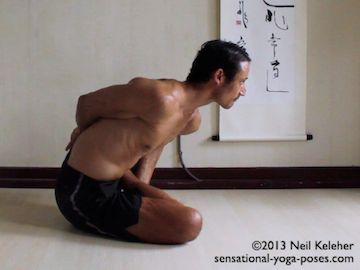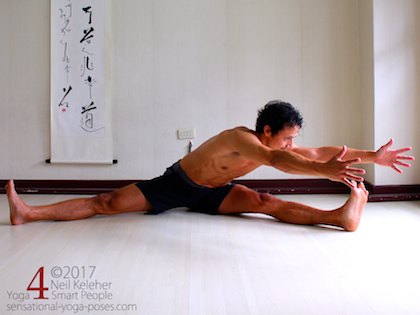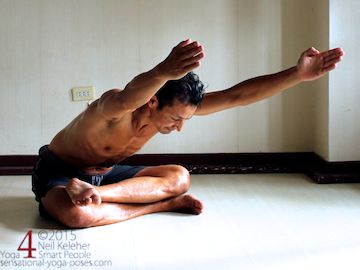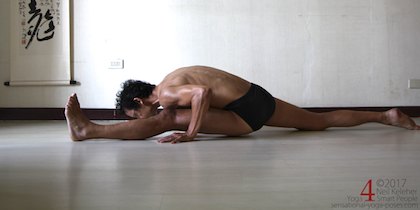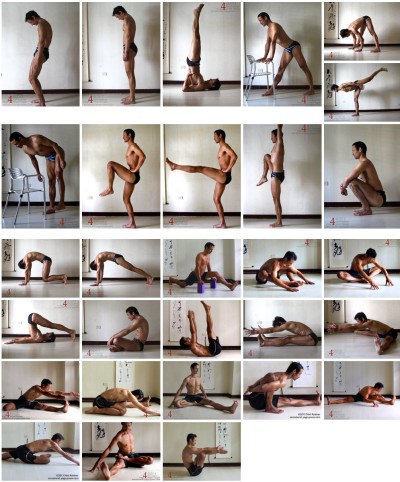Yoga Forward Bends Index
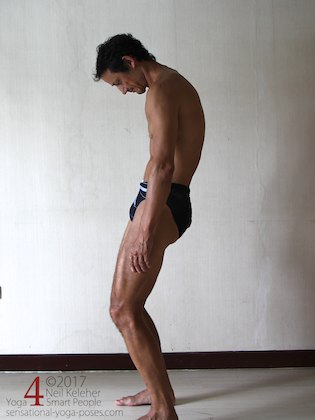
Standing spinal front bend
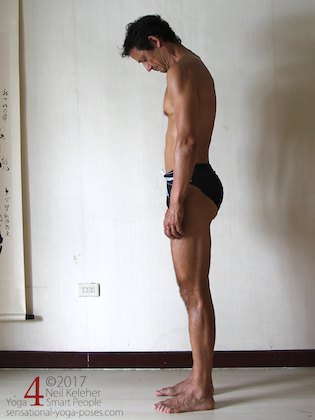
Forward bend for the neck
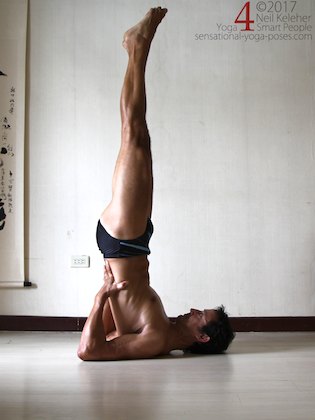
Shoulder stand
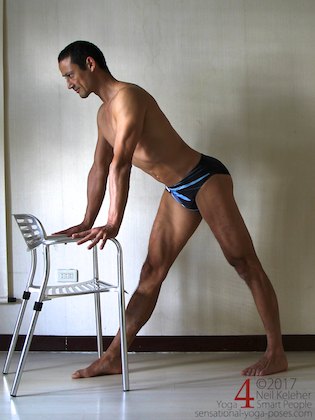
Pyramid pose
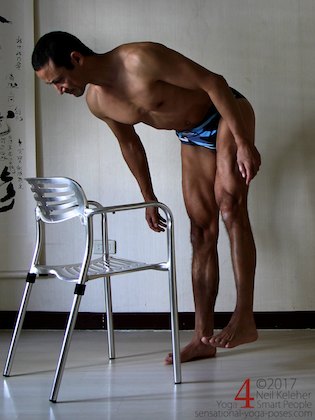
Forward bend with one leg lifted
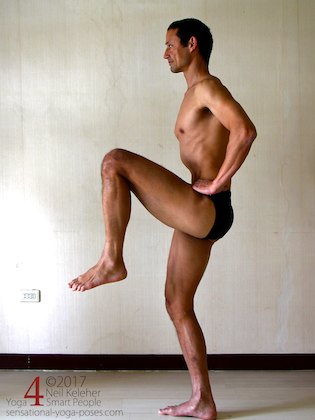
Standing knee lift
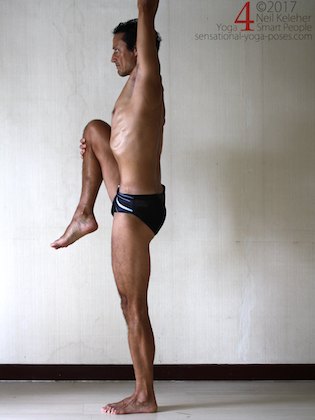
Standing knee hug
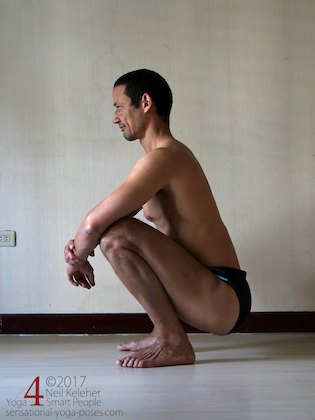
Squat
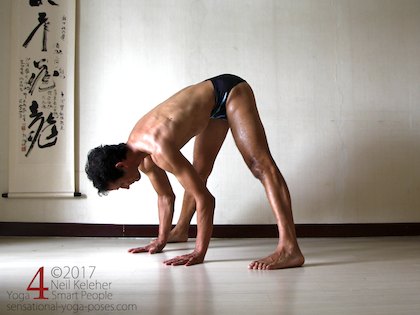
Standing wide leg forward bend
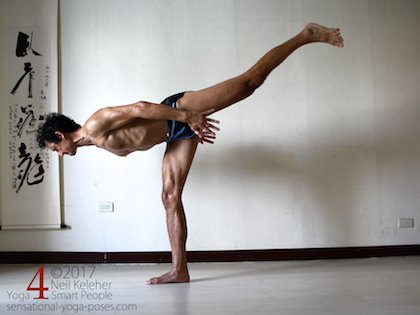
Warrior 3

Dog pose knee lift
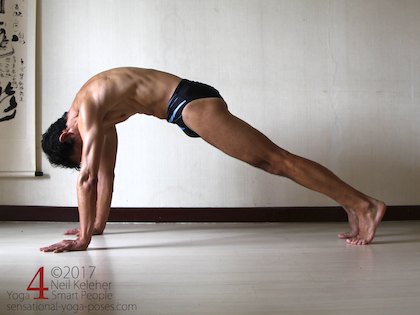
Plank pose with spinal forward bend
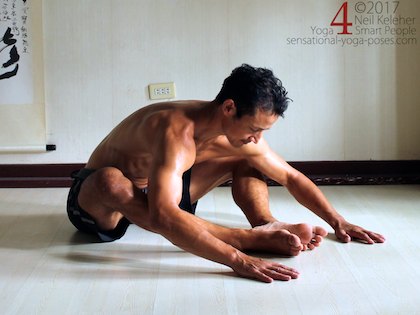
Wide bound angle pose
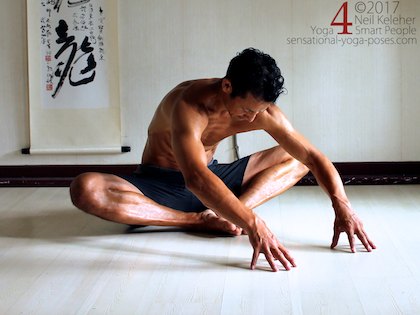
Bound angle pose
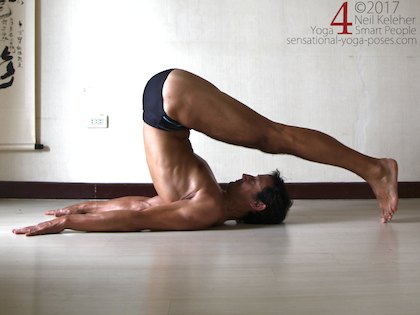
Plough pose forward bend for neck, hips
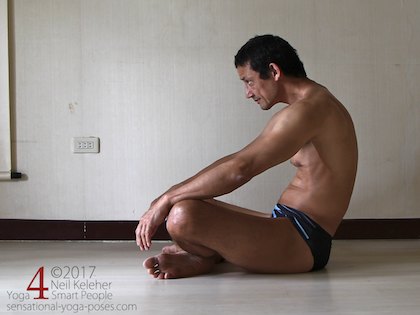
Seated spinal forward bend
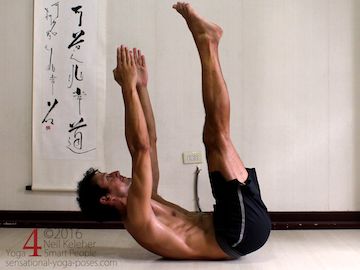
Dead dog spinal forward bend
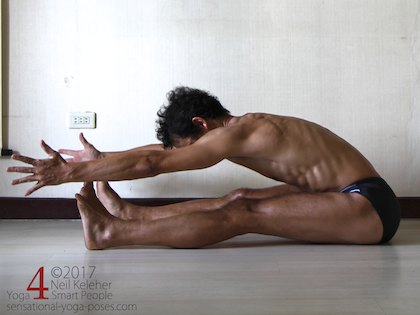
Seated forward bend
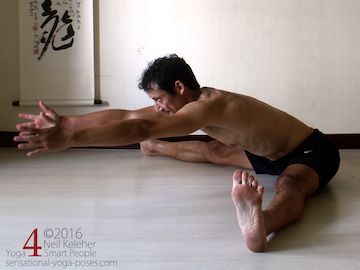
Seated wide leg forward bend
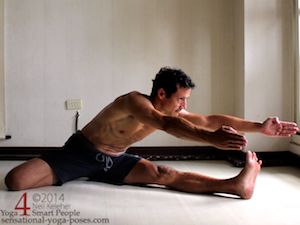
Hurdlers stretch
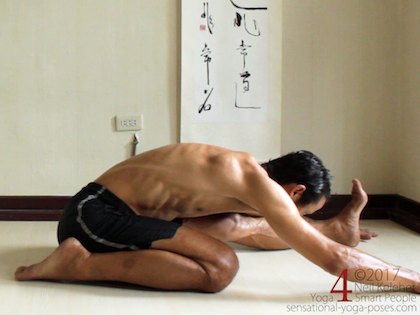
Half hero forward bend
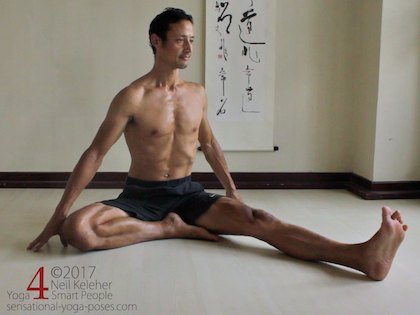
Janu sirsasana forward bends
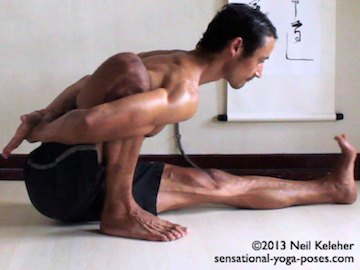
Marichyasana forward bends
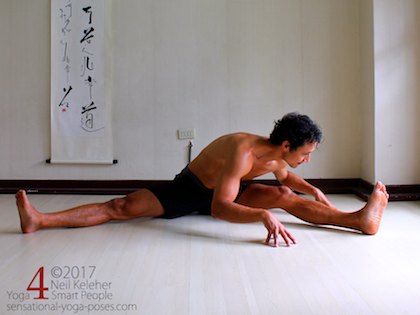
Wide leg forward bend to one leg
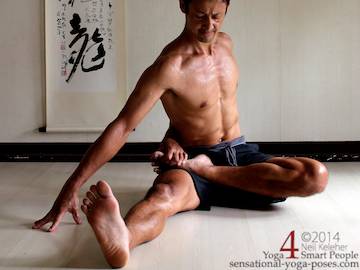
Seated half bound lotus
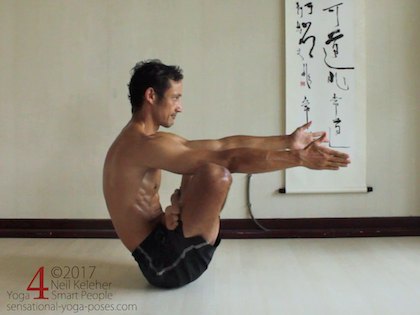
Seated lotus with knees to chest
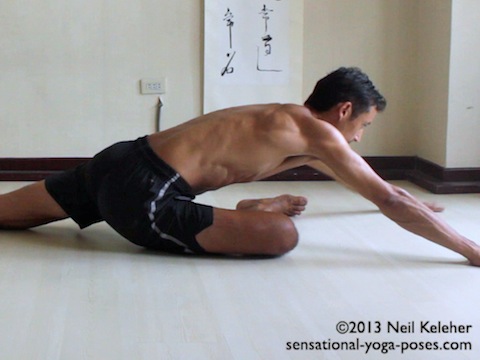
Pigeon pose forward bend
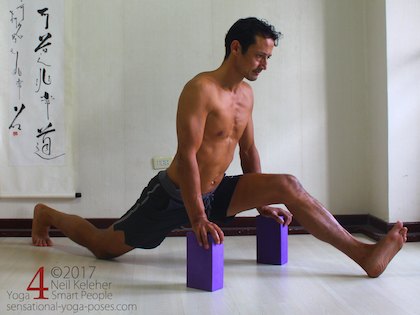
Splits
Focusing on the spine, simple forward bends for the spine can be done while standing with the torso upright..
If you do choose to bend the spine forwards, work at feeling your spine as you do it. Feeling the spine isn't a passive process. Instead you have to turn on your spinal muscles so that you can feel your spine. (It's like turning on your iphone so that its touch sensor can activate). Proprioception needs active muscles.
A simple way to feel your spine is to make it feel long in such a way that the spinal erectors activate.
After you can make your spine feel long while straightening it, try to create the same feeling when bending it forwards.
The spine can also be bent forwards while sitting or kneeling with the torso upright.
It can be easier to learn while sitting since it is easier to tilt the pelvis backwards while either kneeling or sitting cross legged.
(You can also practice while sitting in a chair though you may find that you already tend to do this naturally).
Spinal front bends can be done on all fours (belly down) in dog pose.
For dog pose, knees can be on the floor (easier).
To exercise your abs you can you can lift your knees a slight amount (harder).
Even without lifting your knees you can activate your abs by:
- first contracting your sternum towards your pubic bone (to bend your thoracic spine and upper lumbar spine forwards)
- Then contract your pubic bone towards your sternum to bend your lower lumbar spine forwards.
From here you could step your one foot back at a time for plank pose, keeping your knees straight while keeping your spine bent forwards.
Another way to exercise your abs while bending your spine forwards is to do it while lying on your back in dead dog pose.
This again requires the use of the abs in order to forward bend your spine.
You could simply lift your pelvis. Then lift your upper back and head.
For improving proprioception (body awareness), try lengthening your spine prior to lifting your pelvis and upper back.
Because the neck is bent forwards in both plough pose and shoulderstand, you might find both of these poses more comfortable if you warm up with a sitting or standing forward neck bend.
In either case, try to make both your neck and your thoracic spine (back of the ribcage) feel long as you hold the forward bend.
For a "smoother" forward bend in your neck you may have to bend your upper thoracic spine forwards also. Whether you do this or not, work at creating a feeling of length at the back of your neck and carrying that into your thoracic spine and down the rest of your spine.
Try carrying this awareness into plough pose and shoulderstand.
An inverted yoga pose where the neck is bent forwards is shoulder stand (salamba sarvangasana).
In shoulder stand you can make your neck feel safer by learning to feel your center of gravity and position it over you shoulders.
You may find that you are scared of tipping backwards and your neck taking the brunt of punishment from a fall.
With an awareness of your center of gravity and how to control it you can get more comfortable in this inverted yoga pose.
In plough pose (halasana) both the neck and hips are bent forwards.
Plough pose can be a bit more dangerous for your neck in the transition from feet on the floor to lifting them and so
when exiting plough pose, prior to lifting your feet, make sure that you brace your neck so that it is ready to bear the weight of your legs once your feet come off of the floor.
Or learn how to shift your weight forwards so that your feet are bearing no weight prior to lifting them.
There are two articles on standing forward bends.
Pyramid Pose is a standing forward bend done with one leg forwards and the other leg back.
You can rest your hands on the floor or, if you can't reach it, on a chair. This helps to reduce the load on the hamstrings and glutes making it easier to give them a relaxed stretch.
That being said, you strengthen your hamstrings, glutes and spinal erectors in pyramid pose by lifting your hands.
When lifting your hands you can reduce the load on your hamstrings and spinal erectors by reaching your arms back (and making them feel long).
To increase the load reach your arms to the sides (not shown) and to increase it further, reach them forwards.
Note that in both of the above versions of pyramid pose one of the main actions is making the spine long. This is an action that you can learn to feel or proprioceive.
Standing wide leg forward bend is another standing hamstring stretch that can be done with hands on the floor, grabbing the bit toes, or on the waist or grabbing each other behind the neck.
With hands on the floor or gripping your big toes, you have the option of using your arms to help your forward bend.
In either case you may find that your arms and legs both activate.
With hands lifted, you can learn to use your hip flexors to help your forward bend.
You may find that making both your legs and spine feel long makes this easier.
Warrior 3 is a balancing on one foot pose that is a forward bend for the standing leg.
You could focus on making your spine and legs feel long. You may find that adding tension makes it easier to stay balanced.
To increase the forward bend of your standing leg hip you can tilt your pelvis forwards. You can move your ribcage with your pelvis as you do this or keep your ribcage relatively still.
In the latter case you increase the back bend of your lumbar spine.
In either case you can keep the leg at the same height or try lifting it higher as if working towards a standing split.
An active forward bend for the hip you can do while standing is to lift one knee towards your chest while balancing on the other leg.
A little bit more challenging is to straighten the knee after lifting it.
This is covered in hip flexor strengthening exercises.
You can adapt the previous pose into a passive forward bend for the hip (at least passive in the sense that the hip muscles can relax) by hugging the knee to your chest using one or both arms.
If you flatten the lumbar curve while doing this you can use this position as a standing psoas stretch for the standing leg.
Another pose that could be considered an active forward bend is bending forwards on one leg.
You can start in a forward bend with hands on the floor. Then lift one leg, and then, if you like, the arms. The pose becomes more interesting when you actively pull the lifted leg forwards.
Because the lifted leg is down instead of back, this pose can be more difficult for the standing leg than warrior 3 because the pelvis has to shift back relative to the supporting foot.
That puts more stretch on the standing leg hamstring.
But because it has to stay active, you are actually actively stretching the hamstring while at the same time exercising the hip flexors of the lifted leg.
Note that if a forward bend is intended as a hamstring stretch then the knees have to be straight. However it is possible to forward bend at the hips with the knees bent.
An example is squatting. In a deep squat, the hips can be fully bent forwards with the knees against the chest.
Forward bends with the knee (or knees bent) are covered in a little more detail in hip extensor stretching variations.
The symmetrical seated forward bend paschimotanasana can be done with the hands on the floor, reaching forwards, grabbing the big toes, grabbing the sides of the feet or even hooking the hands over the feet.
If grabbing the feet in some way you can push your legs forwards to resist the backwards pull of your arms.
If not grabbing the feet, you can work at creating the sensation of length in the arms, legs and spine, while at the same time resisting that length.
Another symmetrical seated yoga forward bend is wide leg forward bend. Generally this is done with the knees pointing upwards.
To stretch the hamstrings in this seated yoga forward bend, the legs shouldn't be opened past 90 degrees.
You can add weight to this yoga seated forward bend by lifting your hands. For more read upavistha konasana
Another seated yoga forward bend is bound angle (baddha konasana or butterfly). In this seated yoga pose the knees are bent with the feet together.
With feet further forwards (away from the pelvis) this forward bend tends to work on the outer thighs. This position can also be easier to bend forwards in.
With feet pulled in, towards the pubic bone, this pose tends to work more on the inner hips and thighs.
It can also be harder to bend forwards.
If grabbing the feet in this latter position use your arms and legs against each other. If you are keeping your hands free play with using your hip and foot muscles to make this yoga forward bend easier.
Asymmetrical forward bending yoga poses can include poses where one leg is straight.
Hurdlers stretch, with thighs open 90 degrees, can be done in such a way that the forward bend is towards the straight leg.
As with most of the other yoga forward bends with one or both legs straight, you can work at making your spine and straight leg feel long.
You could also work at creating tension in the bent knee hip to make the hip better integrated and comfortable in this pose.
You can also bend forwards between the thighs for a pose that not only stretches the hamstrings of the straight leg but works on the hip of the bent knee leg.
While the straight leg is still important in this forward bending position, you may find that the bent knee hip is under more stress and so play with activating the bent knee hip to make it more comfortable. (And if bending forwards is too much, then just do this pose in an upright position.
Note that lengthening your lumbar spine may make it easier to control both your bent knee hip and your straight knee hip.
If you are worried about your bent leg knee, because of the position of the foot (turned out with the inner edge of the foot on the floor) a potential preparation (or substitute pose) is half hero pose, the next pose below.
Both of these poses rotate the bent knee thigh inwards at the hip. They also rotate the shin. (More on that below.)
In triang muka eka pada paschimotanasa, or half hero forward bend, the shin of the bent knee leg is folded to the outside of the thigh with the top of the foot on the floor.
The thighs in this pose can be roughly parallel.
Because the shin is folded to the outside of the thigh (in full hero you try to sit between your heels with your bum on the floor) the thigh has to rotate inwards to accomodate.
It might seem strange but with the knee fully bent, internal rotation of the shin positions the foot towards the outside of the thigh while external rotation positions it towards the inside of the thigh.
This rotational ability of the shins relative to the thighs may be what allows us to squat comfortably with a variety of foot positions.
And with the knee fully closed, it allows us to sit with the foot to the inside of the thigh or thte outside of it.
The janu sirsasana series consists of three poses with the bent knee shin folded to the inside of the thigh.
In the pictures I'm upright as opposed to forward bending so that you can see the foot position.
In janu sirsasana C the shin is rotated externally to point the foot down and this is one reason why I suggest using it, and variations of its foot position as a preparation for lotus.
If in Janursisasana B you point the foot to the side as opposed to forwards, you may be allowing the shin to externally rotate to a greater degree.
Marichyasana A and Marichyasana B are both forward bends. One has a straight leg the other does not.
Both of these forward bending poses can be done without binding.
To prevent "tipping away" from the marichyasana leg when doing these poses unbound, you can use your non-marichyasana hand against the floor to push you forwards and towards your marichyasana side. This can also be a helpful variation for learning how to stabilize the SI joint in Marichyasana..
Note that this yoga pose is a forward bend for the marichyasana hip but with the knee bent and that's the reason why this pose is classified as a hip extensor stretching variation.
With legs opened wide and knees straight, you can bend forwards towards one leg at a time turning a symetrical position into an asymmetrical one.
Bending towards your left foot, you may find that you get a slight spinal side bend to the left. You have to lengthen the right side of your waist, particularly if you keep the pelvis stable.
In addition, if you try to turn your ribcage so that it faces downwards, you also add a twist to your spine.
This could be used as a preparation or warm up for bending forwards between the legs.
Half bound lotus is a forward bend with one leg straight and the other folded in lotus.
You could bend forwards with your foot in lotus without binding.
If your right foot is in lotus, you could grab it with your left hand, then with your right hand, grab your left upper arm or forearm from behind your back for a simulated bound lotus.
If you can get both legs in lotus for full lotus, you can bend forwards (with or without binding) by bending your torso towards your legs (not shown.)
You could also forward bend the hips by lifting your legs towards your torso.
One of the things to notice when doing yoga seated forward bends like half bound lotus forward bend, full lotus forward bend or janu sirsasana C is how the heel presses into some part of the abdomen, provided you can bend forwards far enough.
Because of this, one substitute for full lotus forward bend is to kneel and bend forwards with your forearms on top of your thighs and your hands closed into fists. Then your fists can press into your belly in the same way that your heels would in lotus.
While considered more of a hip stretch, you can bend forwards in pigeon pose (either with the front hip lifted or on the floor).
You can also bend forwards in double pigeon.
Front to back splits with the torso upright could be considered a forward bend for the front leg.
Bending forwards while in split makes the forward bend more extreme (and reduces the stretch on the hip flexors of the back leg.)
One way to make splits more active is to activate the hamstrings and glute of the back leg and at the same time activate the hip flexors of the front leg.
Published: 2017 09 28
Updated: 2019 12 04




























